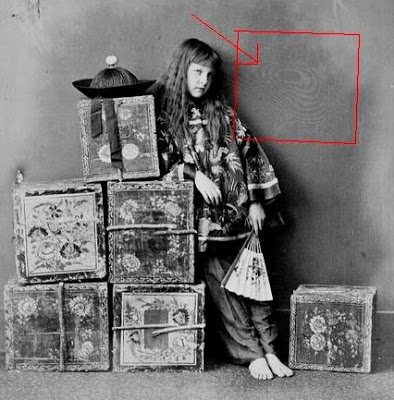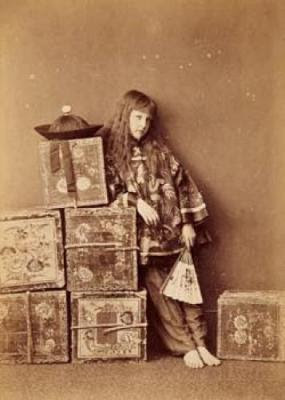Philosophy
Long before sitting at the computer and manipulating images, the realm of the darkroom ruled and when making prints via contact of glass plate negative with sensitized paper using a contact print frame this issue may occur. The phenomenon will also occur with large format enlargers when an acetate negative is sandwiched between two pieces of glass. And I have been told that it may happen with scanners.
 "Tea-Merchant" [Off Duty]
"Tea-Merchant" [Off Duty]
1873
Xie Kitchin
Lewis Carroll [Charles Dodgson]
Department of Rare Books and Special Collections
Princeton University Library
 Corrected print using anti-Newton Ring glass.
Corrected print using anti-Newton Ring glass.
Here are the physics:

The phenomenon of Newton's rings, named after Isaac Newton, is an interference pattern caused by the reflection of light between two surfaces - a spherical surface and an adjacent flat surface. When viewed with a monochromatic light it appears as a series of concentric, alternating light and dark rings centered at the point of contact between the two surfaces. When viewed with white light, it forms a concentric ring pattern of rainbow colors because the different wavelengths of light interfere at different thicknesses of the air layer between the surfaces. The light rings are caused by constructive interference between the light rays reflected from both surfaces, while the dark rings are caused by destructive interference. Also, the outer rings are spaced more closely than the inner ones. Moving outwards from one dark ring to the next, for example, increases the path difference by the same amount λ, corresponding to the same increase of thickness of the air layer λ/2. Since the slope of the lens surface increases outwards, separation of the rings gets smaller for the outer rings.
The equation for the radius of the mth Newton's bright ring goes as follows:

where:
The phenomenon was first described by Robert Hooke in his 1664 book Micrographia although its name derives from the physicist Isaac Newton, who was the first to analyze it.
- Was Griffin [wells' Invisible Man] Like Other Evil Creatures?
The "Invisible Man" isn't a created monster or alien invader but a result of his own experimentation. [Somewhat akin to Robert Louis Stevenson's Strange Case of Dr Jekyll and Mr Hyde.] When I read H. G. Wells' book, I was never really sure...
- Andrew Ellicott Douglass...astronomer And Dendrochronologist
Andrew Ellicott Douglass July 5th, 1867 to March 20th, 1962 Minnesota State University · Mankato, Minnesota... Andrew Douglass was an American astronomer who's major accomplishment was perfecting the dendrochronology. When he was 27 and working...
- Newton's Alchemy
Yes, NOVA [ "Newton's Dark Secrets"--transcript ] had a special [highly dramatized] program on Newton and his interest in alchemy. "IU team reveals secret life of Isaac Newton on new website" June 14th, 2010 Indiana University Sir Isaac Newton,...
- Mimas--pac-man
A slow science day? "1980s Video Icon Glows On Saturn Moon" March 30th, 2010 SATURN DAILY The highest-resolution-yet temperature map and images of Saturn's icy moon Mimas obtained by NASA's Cassini spacecraft reveal surprising patterns on...
- Robert Hooke...1703
Robert Hooke July 18th, 1635 to March 3rd, 1703 Robert Hooke, an English natural philosopher, died March 3rd, 1703. Hooke made his own microscopes and rendered fine illustrations of what he observed. Hooke did not get along well with his contemporary...
Philosophy
Newton's Rings
Long before sitting at the computer and manipulating images, the realm of the darkroom ruled and when making prints via contact of glass plate negative with sensitized paper using a contact print frame this issue may occur. The phenomenon will also occur with large format enlargers when an acetate negative is sandwiched between two pieces of glass. And I have been told that it may happen with scanners.
1873
Xie Kitchin
Lewis Carroll [Charles Dodgson]
Department of Rare Books and Special Collections
Princeton University Library
 Corrected print using anti-Newton Ring glass.
Corrected print using anti-Newton Ring glass.Here are the physics:

The phenomenon of Newton's rings, named after Isaac Newton, is an interference pattern caused by the reflection of light between two surfaces - a spherical surface and an adjacent flat surface. When viewed with a monochromatic light it appears as a series of concentric, alternating light and dark rings centered at the point of contact between the two surfaces. When viewed with white light, it forms a concentric ring pattern of rainbow colors because the different wavelengths of light interfere at different thicknesses of the air layer between the surfaces. The light rings are caused by constructive interference between the light rays reflected from both surfaces, while the dark rings are caused by destructive interference. Also, the outer rings are spaced more closely than the inner ones. Moving outwards from one dark ring to the next, for example, increases the path difference by the same amount λ, corresponding to the same increase of thickness of the air layer λ/2. Since the slope of the lens surface increases outwards, separation of the rings gets smaller for the outer rings.
The equation for the radius of the mth Newton's bright ring goes as follows:

where:
R is the radius of curvature of the lens the light is passing through,
m is 0,1,2,3... which is dependent upon the number of light spots,
λ is the wavelength of the light passing through the glass.
m is 0,1,2,3... which is dependent upon the number of light spots,
λ is the wavelength of the light passing through the glass.
The phenomenon was first described by Robert Hooke in his 1664 book Micrographia although its name derives from the physicist Isaac Newton, who was the first to analyze it.
- Was Griffin [wells' Invisible Man] Like Other Evil Creatures?
The "Invisible Man" isn't a created monster or alien invader but a result of his own experimentation. [Somewhat akin to Robert Louis Stevenson's Strange Case of Dr Jekyll and Mr Hyde.] When I read H. G. Wells' book, I was never really sure...
- Andrew Ellicott Douglass...astronomer And Dendrochronologist
Andrew Ellicott Douglass July 5th, 1867 to March 20th, 1962 Minnesota State University · Mankato, Minnesota... Andrew Douglass was an American astronomer who's major accomplishment was perfecting the dendrochronology. When he was 27 and working...
- Newton's Alchemy
Yes, NOVA [ "Newton's Dark Secrets"--transcript ] had a special [highly dramatized] program on Newton and his interest in alchemy. "IU team reveals secret life of Isaac Newton on new website" June 14th, 2010 Indiana University Sir Isaac Newton,...
- Mimas--pac-man
A slow science day? "1980s Video Icon Glows On Saturn Moon" March 30th, 2010 SATURN DAILY The highest-resolution-yet temperature map and images of Saturn's icy moon Mimas obtained by NASA's Cassini spacecraft reveal surprising patterns on...
- Robert Hooke...1703
Robert Hooke July 18th, 1635 to March 3rd, 1703 Robert Hooke, an English natural philosopher, died March 3rd, 1703. Hooke made his own microscopes and rendered fine illustrations of what he observed. Hooke did not get along well with his contemporary...
